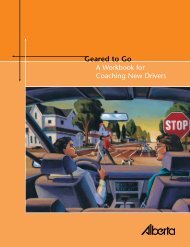Commercial driver's guide to operation, safety and licensing
Commercial driver's guide to operation, safety and licensing
Commercial driver's guide to operation, safety and licensing
Create successful ePaper yourself
Turn your PDF publications into a flip-book with our unique Google optimized e-Paper software.
Step 5 (Air system leaks)<br />
Push both park control valves <strong>and</strong><br />
rebuild air pressure.<br />
Turn off the engine.<br />
Apply <strong>and</strong> firmly hold a full service brake<br />
application for 2 minutes.<br />
Maximum 4 PSI (28 kPa) loss for power<br />
units, plus an additional 2 PSI (14 kPa)<br />
per trailer, after the system stabilizes.<br />
Release service brake application <strong>and</strong><br />
reapply spring park brakes.<br />
Step 6 (Service brake<br />
response)<br />
Remove wheel chocks.<br />
Release spring park brakes.<br />
Perform a brake response test using the<br />
foot valve.<br />
Perform a brake response test using the<br />
trailer h<strong>and</strong> valve.<br />
Enroute check s<strong>to</strong>p<br />
inspections<br />
Rest <strong>and</strong> check s<strong>to</strong>ps serve two purposes.<br />
First, they provide a break <strong>and</strong> a change<br />
of routine. You will feel less tired <strong>and</strong> more<br />
alert after a rest s<strong>to</strong>p. Second, you can<br />
check your vehicle after it has been on the<br />
road for some time. You will be able <strong>to</strong> see<br />
if everything is still secure <strong>and</strong> working the<br />
way it should.<br />
Schedule rest <strong>and</strong> check s<strong>to</strong>ps<br />
according <strong>to</strong> National Safety Code (NSC)<br />
requirements <strong>and</strong> your company’s policy.<br />
When choosing a s<strong>to</strong>p, keep the<br />
following in mind:<br />
• Make sure the vehicle is completely<br />
off the road.<br />
• You should be able <strong>to</strong> enter <strong>and</strong> exit a<br />
rest or check s<strong>to</strong>p so that you do not<br />
have <strong>to</strong> back the vehicle.<br />
• Do not make a s<strong>to</strong>p at the bot<strong>to</strong>m of a<br />
hill or on an uphill slope.<br />
• The s<strong>to</strong>p area should have an adequate<br />
acceleration lane <strong>to</strong> allow you <strong>to</strong><br />
merge on <strong>to</strong> the highway at the<br />
appropriate speed.<br />
A vehicle inspection at a rest <strong>and</strong> check<br />
s<strong>to</strong>p should include the following:<br />
• All lights are clean <strong>and</strong> in working order.<br />
• There are no air leaks.<br />
• All the wheels are secure, <strong>and</strong> tires are<br />
properly inflated <strong>and</strong> are not hot.<br />
• There are no broken or loose items on<br />
the vehicle.<br />
• The load is secure.<br />
• The dangerous goods placards are<br />
clean <strong>and</strong> secure (if applicable).<br />
• The trailer locking mechanisms are<br />
secure <strong>and</strong> in good condition.<br />
• The brakes are properly adjusted.<br />
Reporting <strong>to</strong> a<br />
vehicle inspection<br />
station<br />
One of the most common misconceptions<br />
regarding vehicle inspection stations is<br />
that only large commercial vehicles have<br />
<strong>to</strong> report. The law is that all commercial<br />
vehicles or combinations weighing over<br />
4,500 kg are required <strong>to</strong> report <strong>to</strong> inspection<br />
stations when the highway lights are<br />
flashing. A “commercial vehicle” is defined<br />
as a vehicle operated on a highway by<br />
or on behalf of a person for the purpose<br />
of providing transportation but does not<br />
include a private passenger vehicle.<br />
36 A <strong>Commercial</strong> Driver’s Guide <strong>to</strong> Operation, Safety <strong>and</strong> Licensing




